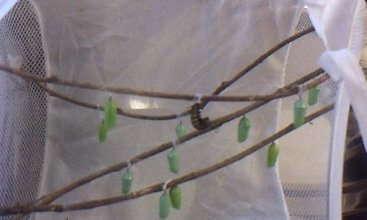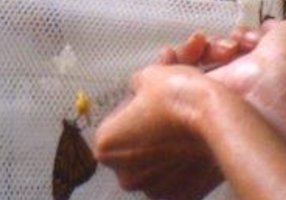We planted Milkweed late last year after hearing of the Monarch Butterfly decline. This year, the plants were getting bigger and starting to fill out. By mid-August, the tall plants appeared to be dying. On closer inspection, the stalks and leaves of the plants were covered with thousands of bright orange aphids. But the true culprit of all the leaf damage turned out to be Monarch caterpillars, approximately 4 dozen of them.
Our brief celebration over our new guests quickly turned to concern as these caterpillars chewed their way through entire clumps of Milkweed each day. It was obvious that there were not enough Milkweed leaves to sustain all these caterpillars through to adulthood. Unfortunately, our local nurseries were also out of Milkweed.
Monarch Caterpillar Rescue
Then one morning, we found 3 younger caterpillars dying at the base of one of the plants. The larger caterpillars were still on the plants, but could be seen fighting over the few remaining leaves. Within 2 days, all the remaining caterpillars were on the ground beneath the plants. All the Milkweed leaves were gone, and they had come down seeking food on the other plants in the flowerbed.
We gathered up all the caterpillars we could find. Some had wandered over to other flowerbed as far as 30 feet away. In all, 19 caterpillars were rescued.
We set them up in a clear plastic container in our pantry, lined with newspaper and thin sticks to crawl on.
What To Feed The Caterpillars
We posted a request to several local online groups asking if anyone in our area had milkweed plants to which we could transfer these caterpillars. It was late in the season and the few responses we received were from people in the same predicament we found ourselves. So we turned to the internet.
Internet research indicated that some people had successfully raised caterpillars on slices of pumpkin; others had used cucumber slices. Our caterpillars were only mildly interested in eating the cucumber. With no pumpkin at the grocery store, we used one of the decorative yellow gourds as well as an acorn squash growing in our garden.
The caterpillars seemed happier with these options, with 50% preferring the acorn squash and 50% feeding on the yellow gourd slices. The cucumber was largely ignored, but we continued to offer it daily just in case their preferences changed.
One thing we learned about our caterpillars was that they were “grumpy”. They preferred a lot of elbow room and didn’t like being too close to one another or sharing food. So we added more sticks and scattered more food around so that they could comfortably continue being anti-social.
Becoming A “J”
In less than a week, our guests had grown significantly. Several had attached themselves to sticks and were hanging in “J” position, beginning the process of pupating. Within a few days everyone had attached themselves to something in the plastic container, with most of the caterpillars preferring to hang from the lid.

The monarch caterpillar in the center is just beginning its J formation
In a “if you blink, you’ll miss it” moment, the skin of the caterpillar would split at the base and the caterpillar would wriggle until it worked the skin all the way to the top, after which it would fall off. The skin of the former caterpillar looks like a crumpled, rolled up sock.
Within 48 hours of attachment and hanging in a “J” shape, each caterpillar would develop into a chrysalis; a lime-green cocoon with a sparkly horizontal line near the top. Not sure what the name of this bejeweled line is, but we called it “Butterfly Bling”.
Out of concern over moisture build up and elbow room after emerging (especially after one of the chrysalis had fallen from the lid), we decided to move the soon-to-be butterflies to a screened container. A pop-up hamper from the dollar store worked perfectly. We carefully removed each chrysalis from the plastic container, making sure to keep as much of the silk threads attached as possible, and transferred them to their new mesh home.
Butterflies!
In under 2 weeks, the butterflies emerged. Each newly emerged butterfly would hang like a wet flower and gently begin flapping its wings to dry them out. Within 8 (more or less) hours, the butterflies were flying about and ready to be released.
Unfortunately for them, the remnants of a tropical storm was passing through so we decided to delay release until it had passed.
But, now instead of worrying about what to feed caterpillars, we were worrying about what to feed butterflies. We brought in one of our hummingbird feeders, and although they tried, the new butterflies couldn’t get the hang of using the feeder.
We ended up hand feeding each caterpillar every few hours until they could get released.

Monarch Butterfly Feeding
Early the next morning, and under calm clear skies, we released our Monarch butterflies and wished them well on their journey.
